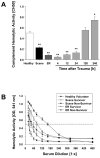Early complementopathy after multiple injuries in humans
- PMID: 22258234
- PMCID: PMC3306539
- DOI: 10.1097/SHK.0b013e3182471795
Early complementopathy after multiple injuries in humans
Abstract
After severe tissue injury, innate immunity mounts a robust systemic inflammatory response. However, little is known about the immediate impact of multiple trauma on early complement function in humans. In the present study, we hypothesized that multiple trauma results in immediate activation, consumption, and dysfunction of the complement cascade and that the resulting severe "complementopathy" may be associated with morbidity and mortality. Therefore, a prospective multicenter study with 25 healthy volunteers and 40 polytrauma patients (mean injury severity score = 30.3 ± 2.9) was performed. After polytrauma, serum was collected as early as possible at the scene, on admission to the emergency room (ER), and 4, 12, 24, 120, and 240 h post-trauma and analyzed for the complement profile. Complement hemolytic activity (CH-50) was massively reduced within the first 24 h after injury, recovered only 5 days after trauma, and discriminated between lethal and nonlethal 28-day outcome. Serum levels of the complement activation products C3a and C5a were significantly elevated throughout the entire observation period and correlated with the severity of traumatic brain injury and survival. The soluble terminal complement complex SC5b-9 and mannose-binding lectin showed a biphasic response after trauma. Key fluid-phase inhibitors of complement, such as C4b-binding protein and factor I, were significantly diminished early after trauma. The present data indicate an almost synchronical rapid activation and dysfunction of complement, suggesting a trauma-induced complementopathy early after injury. These events may participate in the impairment of the innate immune response observed after severe trauma.
Figures






References
-
- Kohl J. The role of complement in danger sensing and transmission. Immunol Res. 2006;34(2):157–176. - PubMed
-
- Matzinger P. The danger model: a renewed sense of self. Science. 2002;296(5566):301–305. - PubMed
-
- Fosse E, Mollnes TE, Aasen AO, Trumpy JH, Stokke T. Complement activation following multiple injuries. Acta Chir Scand. 1987;153(5-6):325–330. - PubMed
-
- Fosse E, Pillgram-Larsen J, Svennevig JL, Nordby C, Skulberg A, Mollnes TE, Abdelnoor M. Complement activation in injured patients occurs immediately and is dependent on the severity of the trauma. Injury. 1998;29(7):509–514. - PubMed
Publication types
MeSH terms
Substances
Grants and funding
LinkOut - more resources
Full Text Sources
Other Literature Sources
Miscellaneous

